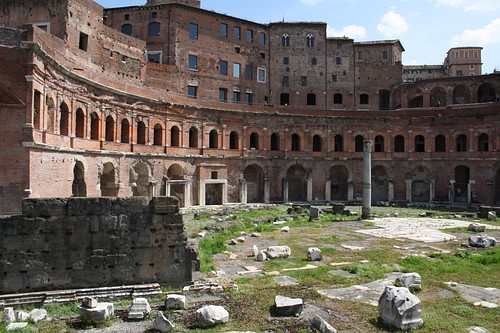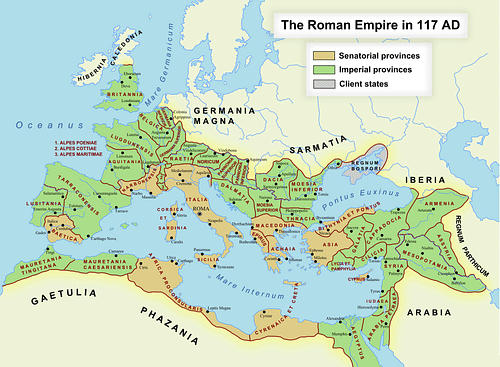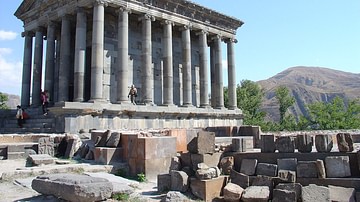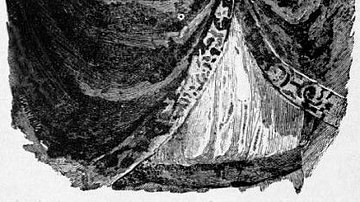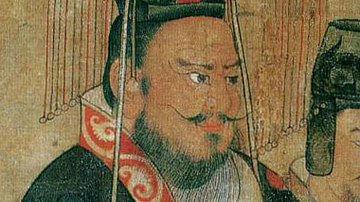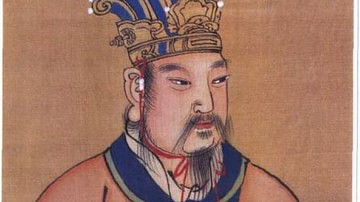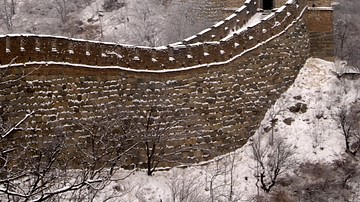
Trajan, or Marcus Ulpius Traianus, was Roman emperor from 98 to 117 CE. Known as a benevolent ruler, his reign was noted for public projects which benefitted the populace such as improving the dilapidated road system, constructing aqueducts, building public baths and extending the port of Ostia. Trajan was also a highly successful general and won three major conflicts against the Dacians and in the east, resulting in the Roman Empire reaching its greatest size up to that date.
Rise to Power
After safely escaping the Praetorian Guard mutiny, the ailing Roman emperor Nerva began to question his own mortality and realized the urgency to name a successor. Without any children of his own, he recognized his only option was to adopt. The choice was not a difficult one. He named Marcus Ulpius Traianus - better known as Trajan - the recently named governor of Upper Germany as his “son.” On January 28, 98 CE Nerva died a natural death and Trajan was quickly named emperor by the Roman Senate, the second of those who would become known as the Five Good Emperors.
The new emperor was born on September 18, 53 CE in Italica (Seville) in the Roman province of Hispania, becoming the first emperor born outside of Italy as his family had its origins in northern Italy. He came from a family with a very impressive military reputation. His father, a career soldier also named Marcus Ulpius Traianus, had been governor of both Baetica in Spain and Syria, a commander during the Jewish War of 67-68 CE as well as a senator and a Roman consul. Young Trajan entered the army at an early age, serving as a tribune under his father in Spain and commander in the Seventh Legion in northern Spain. Luckily, Trajan's usefulness was recognized by Domitian (81-96 CE), and he was able to avoid the paranoid emperor's reign of terror. In January 89 CE the youthful commander marched to the Rhine to help Domitian battle Saturninus, the rebellious governor of Upper Germany; unfortunately, he arrived too late to be of any assistance. Despite this, Domitian showed his appreciation by naming Trajan as praetor (85 CE) and later a consul (91 CE).
Following Domitian's assassination in 96 CE, the new emperor Nerva appointed the highly respected Trajan as governor of Upper Germany - a rather smart move by the emperor since it gained him the necessary support of the military. Shortly after his appointment in October 97 CE, Trajan received a handwritten note from Nerva notifying him of his adoption. Although Trajan did not hurry to Rome, he did think it necessary to solve the controversy surrounding the mutiny by the Praetorian Guards who had wished to punish the assassins of Domitian. Trajan sent for the conspirators, especially Casperius Aelianus - the guard who had engineered the mutiny - to meet him in Upper Germany to receive a special commission. According to historian Cassius Dio, Trajan offered “to employ them for some purpose and then put them out of the way.”
Early Rule
When Nerva died in January 98 CE, Trajan did not immediately return to Rome. Instead, he inspected the Rhine and Danube frontiers to not only safeguard against the Dacians but also to test the allegiance of many of the legions still loyal to Domitian. Finally, in the summer of 99 CE, he made his entry into Rome on foot where he mingled with both the citizenry and senators. Pliny the Younger (61-112 CE) - a lawyer, author, and governor of Bithynia - often corresponded with Emperor Trajan on a variety of topics. After Nerva's death and Trajan's ascension, Pliny wrote one of his many letters to the new emperor, ”May you then, and would through your means, enjoy every prosperity worthy of your reign: to which let me add my wishes, most excellent Emperor, upon a private as well as public account, that your health and spirits may be preserved firm and unbroken.”
Although he maintained an excellent rapport with the Senate, Trajan was still considered an absolute ruler but not to the degree of Domitian or even Nerva. Cassius Dio wrote, “Trajan was most conspicuous for his justice, for his bravery, and for the simplicity of his habits.” As an emperor who was concerned with both good government and the public welfare, he instituted an excellent domestic policy - providing for the children of the poor, restoring the dilapidated road system, as well as building new bridges, aqueducts, public baths, and a modern port at Ostia. Lastly, he continued his predecessor's policy of undoing much of the harm done by Domitian by freeing prisoners and recalling exiles.
Dacian Campaigns
While historians have identified him as a thoughtful emperor, Trajan's real passion was war (and he was very good at it). During his 19 year reign, he was involved in three major wars - the first two with the Dacians and the last on the eastern frontier. Under Domitian he had been involved briefly with King Decebalus and the Dacians along the Danube River but without any clear success. In 101 CE Trajan left Rome to battle the Dacians, quickly defeating them at Tapae. After another failed attack, they immediately sued for peace. This time, however, Decebalus was forced to cede considerable territory north of the Danube but the Dacian king had never been one to respect a peace agreement.
In 105 CE Trajan returned to the north to fight the pesky Dacians once again. Unfortunately for Decebalus, many of his allies deserted him as Trajan and his Roman army approached. After the king's defeat, the Romans continued on to the Dacian capital of Sarmizegethusa where their entire treasury was seized and sent back to Rome. In fear of being captured, Decebalus perhaps wisely committed suicide (his severed head was put on display in Rome.) The kingdom of Dacia was absorbed into the Empire; however, to prevent any further disruptions, Dacia was emptied of over half a million people, and replaced by Roman colonists, making it the “Land of the Romans” or modern-day Romania. After Trajan returned to Rome victorious, he celebrated by holding a series of gladiatorial contests involving over 10,000 gladiators and causing the deaths of at least 11,000 animals.
Expansion
For the next six years the Empire saw a period of relative peace, but in 114 CE war came to the eastern frontier. In response Trajan would leave Rome for the last time, never to return. The war began when the Parthians placed one of their own on the throne of Armenia, a Roman buffer state. This “upset the delicate balance of power” on the eastern frontier. Trajan intervened, and Armenia was made a province of Rome. The army continued on eastward and annexed Mesopotamia, including the Parthian capital of Ctesiphon. Under Trajan, the Roman Empire now stretched further than it ever had - from Scotland to the Caspian Sea. In 117 CE the Mesopotamians rebelled, forcing Trajan to retreat and during the battle, Trajan almost died when an arrow meant for him struck and killed one of his bodyguards. Dio wrote, “…the enemy, seeing his majestic gray head, and his august countenance, suspected his identity, shot at him and killed a cavalryman in his escort.”
Rebellion among the Jewish population broke out in Cyrenaica, spreading to both Egypt and Cyprus; however, when trouble broke out on the northern frontier, Trajan left his army in Syria and retreated to Rome. On his way, he fell ill (some suspect poison) upon reaching Selinus in Cilicia; he died on August 9, 117 CE. His body was returned to Rome where it was cremated and buried in an urn at the base of the great Trajan's Column.
Building Projects
Trajan's memory remained in Rome for generations to follow, primarily due to two gifts he gave the city - the Forum of Trajan and Trajan's Column. The Forum of Trajan, financed by the seized Dacian treasury, was dedicated in 112 CE. The population of Rome at the time of Trajan and Nerva had grown to its greatest height, close to one million, and it needed (and people felt they deserved) a new forum, not only a marketplace and shopping center but also a center for politics, commerce, and religion. The forum lay between the Quirinal and Capitoline Hills. On either side of the plaza were two semi-circular, six-story buildings, containing great halls and rooms for offices. North of the forum was a new basilica - Basilica Ulpias - that housed law courts. After Trajan's death, Emperor Hadrian would add a large gateway and a statue of Trajan riding a six-horse chariot. The forum's architect Apollodorus of Damascus had also designed Trajan's Bridge across the Danube - the longest arch bridge in the world until its destruction in 275 CE. Unfortunately for the architect, Hadrian would have him exiled and later executed.
Trajan's second gift, Trajan's Column, was dedicated in 113 CE. At the base of the 100-foot column were a number of friezes depicting his battles against the Dacians. A stairwell took people to a viewing platform at the top, and at the column's summit stood a statue of Trajan - the statue was later replaced by one of St. Peter.
Heir
Like his predecessor, however, Trajan and his wife were childless and, like Nerva, he chose adoption to solve the problem of an heir. He adopted and named his cousin's son Hadrian as his successor. However, rumors persisted that Hadrian had never been officially adopted. Trajan's wife Pompeia Plotina supposedly used a ruse - forging documents - to make the adoption official, thus making Hadrian the third of the Five Good Emperors.
